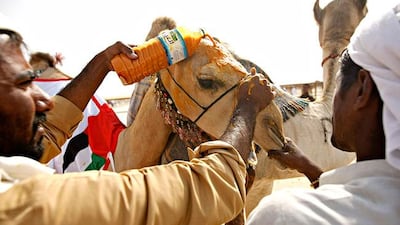If you don't have a camel, don't worry. You can still participate at the Al Dhafra's Camel beauty pageant. Now that you know the basic principles of camel beauty, here's what to expect when you get to Al Dhafra and how to make the most of your visit:
How to get there?
From Abu Dhabi or Dubai, follow the E11 west towards the Ghweifat - Saudi Arabia border. Turn south to Madinat Zayed on the E45 about 100km west of Abu Dhabi. A few minutes south of the town, there is a turn-off on the right for the Tilal Liwa Hotel, 4.8 km from the city limit sign. The drive takes about two hours.
Around the dunes:
The festival takes place along an eight kilometre stretch of tarmac that winds through the desert to the Tilal Liwa hotel. It begins with a makeshift roadside market with cafeterias and camping equipment. Stop and explore, and don’t forget to haggle.
The handcraft market is on the right before a fork in the road, beside the Ministry of Interior Village. You can buy small handwoven blankets, clay bowls and camel tack made by Omani women who travel the camel race circuit.
At the fork, take a right and then take the left exit at the small roundabout to reach the judging pens near the end of the tarmac road.
Park outside the shaded grandstands, go in and take a seat. Tourists can sit in the VIP section and tour the pens. There are porta-cabin washrooms outside the VIP section.
Millions Street, adjacent to the grandstands, is where camels parade up and down, usually followed by men dancing and honking their 4x4s to impress competitors and attract potential buyers. This is a good place to get photographs and talk to people about their camels.
When to go?
The festival started on Dec 14 with individual competitions classed by year group, culminating in the best herd competitions near the festival’s end on Dec 28.
Competitors parade their camels down Millions Street on the way to the judging pen shortly after sunrise. Competitions run until sunset. It’s not unusual for spectators to sing and dance in the stands, especially before the winner is announced.
What is going on in the judging pens?
Camels are divided according to breed. They are light asayel racing camels or dark majahim camels known for beauty and milk production. Camels are then divided according to whether they were bought or bred by their current owner.
Judging takes place in a series of rounds. The best advance to pens closer to the grandstand. This process begins around 8am and takes hours. As judging progresses, spectators shout and sing to attract their camel’s attention.
The owners of top camels must swear on the Quran about the camel’s age and pedigree before a champion is declared. Its head and neck are then covered in a saffron paste and it is paraded down Millions Street with much fanfare.
In the grandstands...
Men serve small complimentary cups of tea and qawah, or Arabic coffee. Accept all food and drink with the right hand. Drink the coffee quickly and shake it to show you are finished. Pack snacks and drinks to eat in the stands because there is not much on offer. Most people wait until after the competition to share a big lunch at their tent.
Do not be shy to ask spectators what is happening, who the favourites are and which camel they think is best. People love to share their stories.
Why are beauty camels usually with a calf?
Majahim beauty camels are bonded with a calf, usually from a fair asayal camel so that it will stand out in a crowd of black camels. During a competition, the calf is removed and the majahim keeps its head raised, looking for its young.
If the majahim does not naturally bond with the calf, its owner will pretend to put the calf in danger so that the cow instinctually protects it. After this, the majahim considers it her own.
What are all these tents? Where do I put mine?
Camels don't travel alone. They come with an entourage of fans who camp for weeks in elaborate tents strung with lights and flags.
These tents are private but if you happen to drive into a camp, do not worry. People are always welcoming and happy to help and guide visitors. Camps have coffee and tea brewing at all times in case unexpected guests arrive.
You can pitch your tent anywhere. Alternatively, there is the Tilal Liwa Hotel and other hotels in the Liwa Oasis, about 30 minutes south. Book ahead.
Is a 4x4 needed?
Strictly speaking, no. Roads to the grandstands and hotel are paved. Millions Road is gatch and easily handled by a two-wheel drive.
What to wear?
Dress conservatively, wear good walking shoes and pack a hat, sunscreen and long sleeves to stay safe from the sun. Bring a warm jacket for evenings, it gets cold.
Where to eat?
If you didn’t have the foresight to pack a goat and a carving knife, don’t panic. The Tilal Liwa Hotel serves a Dh120 buffet lunch and has an à la carte menu. Madinat Zayed has grocery stores, Indian and Lebanese restaurants and even a Burger Hut and Pizza King. Nope, that’s not a typo.
If you really like your food fresh, you can buy goats and chickens at the roadside market. Firewood is available.
If you are invited to a family lunch, you might find yourself seated around a platter of rice with goat or chicken. Eat with your right hand and tuck in. Hospitality is a hallmark of the region and at Dhafra, you’ll soon see why.

